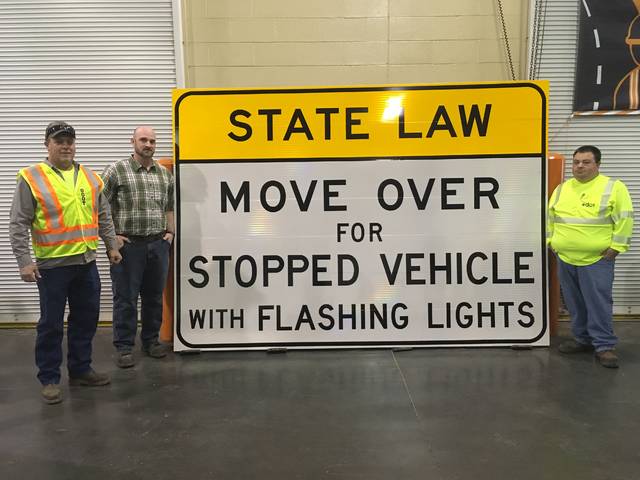
By Megan Alley
Sun Staff
“Slow down and move over for all roadside workers,” is not just a catchy reminder to drivers to use caution in construction zones; it’s the law.
Ohio’s Move Over law requires all drivers to move over one lane, or slow down if it is not possible to change lanes, when passing by any vehicle with flashing or rotating lights parked on the roadside.
The law dates back to 1999, when it was enacted to help protect law-enforcement officers, emergency responders and tow operators.
Then, in December 2013, it was expanded to include every stationary vehicle with flashing lights, including road construction, maintenance and utility crews.
While the expanded law is more than five years old, many drivers are not obeying it.
Last year alone saw nearly 5,000 work zone crashes in the state, resulting in 586 minor injuries, 103 serious injuries, and 14 deaths, with the majority of those injured and killed in work zones being motorists and their passengers, according to a press release from the Ohio Department of Transportation.
To remind drivers and help raise awareness about the Move Over law, ODOT District 8 Deputy Director Tammy Campbell and Ohio State Highway Patrol Clermont County Post Commander Lieutenant Bobby Hayslip held a press conference on April 1 at ODOT’s Clermont County Garage in Amelia.
“Motorists are helping protect the lives of everyone who works on or uses our roadways by moving over,” Hayslip said. “Moving over isn’t only the right thing to do, it’s the law.”
Ohio’s Move Over Law applies to all interstates and state highways, and it can be enforced by any law-enforcement officer.
Fines for not complying with the Move Over law are stiff. Violators will be fined $300 for the first violation, a minor misdemeanor, $500 for the same violation within a year of the first, and $1,000 for more than two violations in a year.
The most common factor in work zone crashes is following too closely. Work zones can result in traffic pattern changes and equipment moving in and out of the work zone, so drivers need to be more cautious and avoid distractions, such as using the cell phone, when driving through these zones.
“If you’re not paying attention, you’re not going to be able to react in time,” Hayslip said.
These reminders of Ohio’s Move Over law come in advance of Work Zone Safety week, which is celebrated April 8 – 12.
Locally, ODOT crews have put up a new warning sign on southbound Interstate 275, before the Wards Corner exit, and there will be a sign installed on northbound Interstate 275, between Beechmont Avenue/state Route 125 and state Route 32.
A third sign will be put up on westbound state Route 32 near the Clermont/Brown County line.
James Ponder, transportation manager for ODOT District 8, will lead crews in putting up the signs reminding drivers to slow down and move over.
The assignment has turned into a passion project for Ponder and his crew, as notably, on May 10, 2017, he, along with three other ODOT workers, were hit by a full size van on southbound Interstate 275 in Milford as they were wrapping up a road patching job.
“If I hadn’t looked into the side view mirror and said, ‘Whoa, we’re about to get hit,’ we would’ve been dead,” Ponder explained. “It was pretty bad; I’m still going to therapy for it and stuff, so it affects our lives, more than just at work … it could have taken us all out.”
Ponder thinks about the possibility of getting hit by a car while working every day.
“It’s very consuming,” he said. “People think that we’re used to it, but there’s no getting used to an 80-mile-an-hour vehicle going this [holds his hands about two feet apart] far from you. So, there is no getting used to that.”
He added, “One heartbeat could have taken four heartbeats, which effects our families, and our every day.”
“We want to go home as much as everyone else does,” one highway technician added.
Highway technician Danny Noertker explained that cars can get way too close to crew workers, noting that a car once hit the handle to the shovel he was using.
Highway technician Larry Scott urged drivers, who might be in a rush to get to work or home, to slow down and use caution in work zones.
He said, “At the end of the day, we’re trying to make the traveling public as safe as possible, but yet we’re trying to stay safe from the traveling public to get home to our families as well.”
